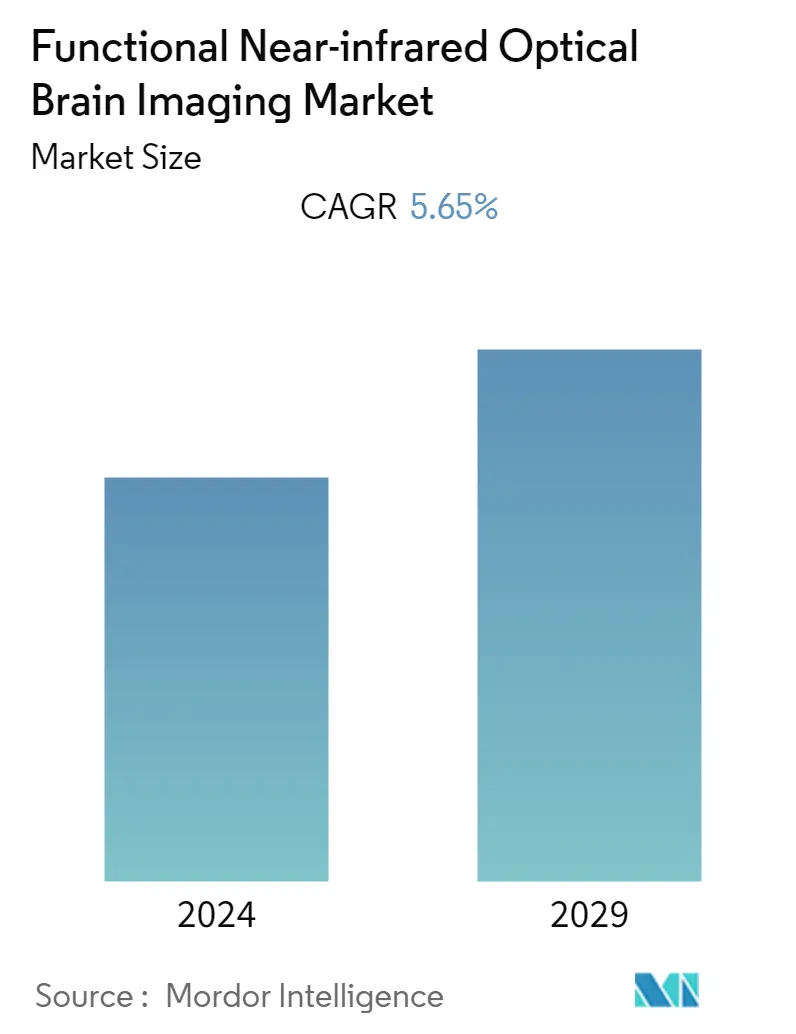Market Size of Functional Near-infrared Optical Brain Imaging Industry

| Study Period | 2019 - 2029 |
| Base Year For Estimation | 2023 |
| CAGR | 5.65 % |
| Fastest Growing Market | Asia-Pacific |
| Largest Market | North America |
| Market Concentration | Medium |
Major Players
*Disclaimer: Major Players sorted in no particular order |
Functional Near-infrared Optical Brain Imaging Market Analysis
The functional near-infrared optical brain imaging market is valued at USD 0.18 billion and is expected to reach USD 0.24 billion by the year 2028, registering a CAGR of 5.65% during the forecast period.
The COVID-19 pandemic was an unprecedented health concern and adversely affected communities, industries, businesses, and lives worldwide. The increase in COVID-19 cases and lockdowns imposed by the government worldwide significantly decreased the incidences of traumatic brain injury in some countries. For instance, according to an article published by the Nature Public Health Emergency Collection, in July 2020, the district of Landeck was quarantined in Austria due to the rapidly increasing number of infections. This resulted in the closure of all ski resorts and hotels, a curfew for all residents, and a ban on outdoor sports activities, which decreased the incidences of brain injuries in Austria. Thus, decreasing traumatic brain injury cases decreased the demand for near-infrared spectroscopy, impacting market growth. However, the market has reached its pre-pandemic nature and is expected to grow strongly in the coming years.
Certain factors propelling the market growth include the rising prevalence of neurological disorders, the rising geriatric population, and emerging product trends. The rising number of neurological disorders coupled with the increasing geriatric population who are more prone to develop neurodegenerative diseases such as Parkinson's, Alzheimer's, dementia, epilepsy, and others are the key factors that are expected to fuel growth in the functional near-infrared optical brain imaging market.
According to the World Alzheimer Report 2021, published in September 2021, over 55 million people lived with dementia worldwide in 2021, almost 60% residing in low- and middle-income countries. The same source projected that the number of people living with dementia will reach 78 million by 2030 and 139 million by 2050. The increasing burden of neurological diseases globally is expected to increase the demand for early detection of the diseases along with monitoring and treatment, which is expected to increase the demand for functional near-infrared optical brain imaging, thereby propelling the market growth.
Moreover, the increasing global geriatric population is also expected to play a significant role in the growth of the studied market as they are more susceptible to various neurological disorders and injuries due to old age, coupled with new technological advancements. As per the data from WHO updated in October 2022, around 80% of the older population globally will be living in low and middle-income countries. Hence, the rising geriatric population in such countries is believed to propel the market growth.
However, a need for more skilled professionals is expected to restrain the growth of the functional near-infrared optical brain imaging market over the forecast period.
Functional Near-infrared Optical Brain Imaging Industry Segmentation
As per the report's scope, functional near-infrared spectroscopy (fNIRS) is a transportable, non-invasive brain imaging technique that uses optical sensors attached to the scalp's surface to monitor changes in cerebral blood flow using low amounts of non-ionizing light. The Functional Near-infrared Optical Brain Imaging Market is segmented by Application Type (Parkinson's Disease, Epilepsy, Dementia, Traumatic Brain Injury, Sleep Disorders, and Other Application Types), End User (Hospitals and Diagnostic Centers), and Geography (North America, Europe, Asia-Pacific, Middle-East and Africa, and South America). The market report also covers the estimated market sizes and trends for 17 countries across major regions globally. The report offers the value (in USD) for the above segments.
| By Application Type | |
| Parkinson's Disease | |
| Epilepsy | |
| Dementia | |
| Traumatic Brain Injury | |
| Sleep Disorders | |
| Other Application Types |
| By End-User | |
| Hospitals | |
| Diagnostic Centers |
| Geography | ||||||||
| ||||||||
| ||||||||
| ||||||||
| ||||||||
|
Functional Near-infrared Optical Brain Imaging Market Size Summary
The functional near-infrared optical brain imaging market is poised for significant growth, driven by the increasing prevalence of neurological disorders and the expanding geriatric population. As more individuals are diagnosed with neurodegenerative diseases such as Alzheimer's and Parkinson's, the demand for advanced imaging techniques to facilitate early detection and monitoring is expected to rise. The market, which experienced a temporary setback due to the COVID-19 pandemic, has rebounded and is now on a growth trajectory. Technological advancements, such as the development of wireless microscale neural sensors, are further propelling the market by offering new insights into brain activity and potential therapies for brain injuries.
North America is anticipated to maintain a dominant position in the market, supported by a growing geriatric population and increased funding for neurological research. The region's market growth is also bolstered by rising investments from private players and strategic initiatives by key companies. Despite the promising growth prospects, the market faces challenges, including a shortage of skilled professionals. However, the ongoing innovation and investment in brain imaging technologies are expected to drive the market forward, with significant contributions from major players like Shimadzu Corporation, Spectratech Inc., and Artinis Medical Systems.
Functional Near-infrared Optical Brain Imaging Market Size - Table of Contents
-
1. MARKET DYNAMICS
-
1.1 Market Overview
-
1.2 Market Drivers
-
1.2.1 Rising Prevalence of Neurological Disorders
-
1.2.2 Emerging Trends in Products
-
-
1.3 Market Restraints
-
1.3.1 Lack of Skilled Professionals
-
-
1.4 Porter's Five Forces Analysis
-
1.4.1 Bargaining Power of Buyers/Consumers
-
1.4.2 Bargaining Power of Suppliers
-
1.4.3 Threat of New Entrants
-
1.4.4 Threat of Substitute Products
-
1.4.5 Intensity of Competitive Rivalry
-
-
-
2. MARKET SEGMENTATION (Market Size by Value- USD)
-
2.1 By Application Type
-
2.1.1 Parkinson's Disease
-
2.1.2 Epilepsy
-
2.1.3 Dementia
-
2.1.4 Traumatic Brain Injury
-
2.1.5 Sleep Disorders
-
2.1.6 Other Application Types
-
-
2.2 By End-User
-
2.2.1 Hospitals
-
2.2.2 Diagnostic Centers
-
-
2.3 Geography
-
2.3.1 North America
-
2.3.1.1 United States
-
2.3.1.2 Canada
-
2.3.1.3 Mexico
-
-
2.3.2 Europe
-
2.3.2.1 Germany
-
2.3.2.2 United Kingdom
-
2.3.2.3 France
-
2.3.2.4 Italy
-
2.3.2.5 Spain
-
2.3.2.6 Rest of Europe
-
-
2.3.3 Asia-Pacific
-
2.3.3.1 China
-
2.3.3.2 Japan
-
2.3.3.3 India
-
2.3.3.4 Australia
-
2.3.3.5 South Korea
-
2.3.3.6 Rest of Asia-Pacific
-
-
2.3.4 Middle-East and Africa
-
2.3.4.1 GCC
-
2.3.4.2 South Africa
-
2.3.4.3 Rest of Middle-East and Africa
-
-
2.3.5 South America
-
2.3.5.1 Brazil
-
2.3.5.2 Argentina
-
2.3.5.3 Rest of South America
-
-
-
Functional Near-infrared Optical Brain Imaging Market Size FAQs
What is the current Global Functional Near-infrared Optical Brain Imaging Market size?
The Global Functional Near-infrared Optical Brain Imaging Market is projected to register a CAGR of 5.65% during the forecast period (2024-2029)
Who are the key players in Global Functional Near-infrared Optical Brain Imaging Market?
Artinis Medical Systems , Soterix Medical Inc. , NIRx Medical Technologies , Shimadzu Corporation and Biopac Systems Inc. are the major companies operating in the Global Functional Near-infrared Optical Brain Imaging Market.

